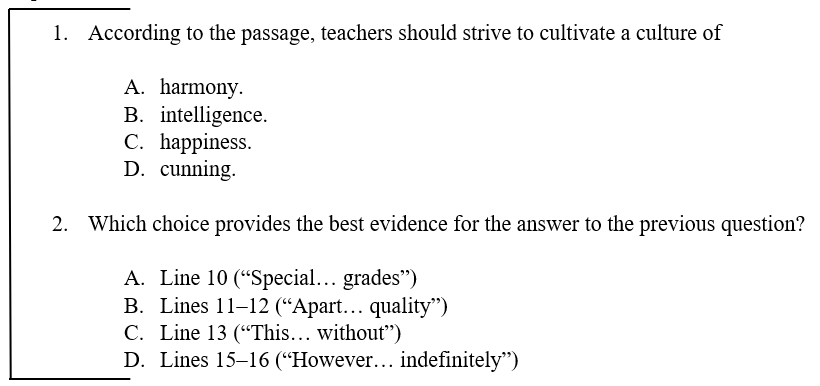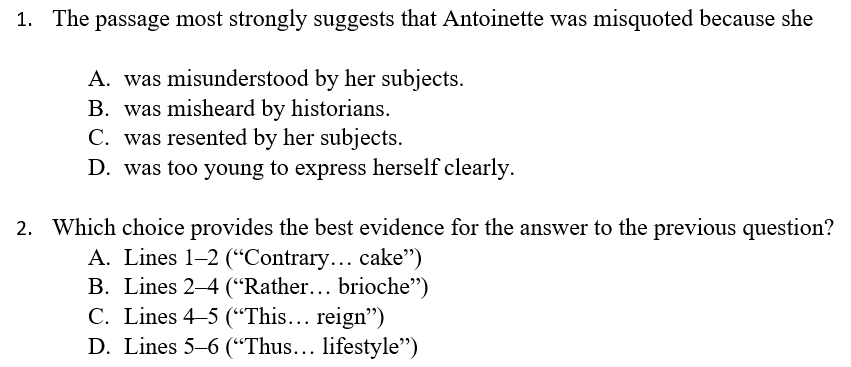One of the most unique features of the SAT Reading Section is the Find the Evidence (FTE) question type. These questions ask you to identify where evidence is given in the passage to support the answer to a corresponding “anchor” question. FTE questions are important not only because they’re likely to come up multiple times throughout the Reading section, but also because they can be used as tools to double check your answers to their anchor questions. That means you double your return on investment when you get them right! It’s therefore a good idea to develop a consistent, reliable approach to these questions.
Identify right away
After you’ve read an SAT Reading passage, go through the questions and locate all the FTE questions. These questions are easy to spot because they always reference the “previous question”. They also always feature line references in the answer choices.
Example:

Group together
Next, group each FTE question with its preceding anchor question to remind yourself that these questions go together.
Example:

Predict the answer
Answer the anchor question like you would any Reading question. When you find the answer, underline the line or lines in the passage that support your selection. Nine times out of ten, your prediction will exactly match the correct answer to the FTE question below it.
Match the FTE answer
Finally, try the FTE question. Usually, the correct answer will align with the text you underlined in the passage. If it doesn’t, there may be something about the anchor question that you didn’t quite grasp. Match each FTE answer to the lines referenced in the text and read carefully. Only one answer will directly address the anchor question. Select this answer and adjust your answer to the anchor question accordingly.
Now that we know how to approach FTE questions, let’s look at a sample mini passage and some corresponding questions:
Contrary to popular belief, Marie Antoinette may not have uttered the infamous words, “Let them eat cake” when reflecting on the state of impoverished pre-revolutionaries in France. Rather, historical documents suggest that it was another, earlier monarch who voiced the related expression, “Qu’ils mangent de la brioche,” or “Let them eat brioche.” This expression became a symbol of discontent with monarchical privilege long before Antoinette was old enough to reign. Thus, it may very well have been misattributed to Antoinette as no more than a gesture of distaste for her lavish spending and lifestyle.

Let’s start by tackling question 1. This question asks what the passage suggests, so we know it’s an inference question. As with any inference question, we want to find what is actually stated in the passage before drawing any conclusions. The passage says a few things about Antoinette and the quote “let them eat cake.” First, it acknowledges that another, earlier monarch probably coined this phrase. But there’s no reason Antoinette couldn’t have said the quote as well, so this fact doesn’t help us understand why people would misquote Antoinette. The passage also states that the original quote became a symbol of discontent with monarchial privilege. We’re getting warmer, but it’s still not clear why people would credit Antoinette specifically with the expression. Finally, the passage tells us there was a general distaste for Antoinette’s lavish lifestyle and spending. Bingo! This tells us why people began associating such a contemptable quote with Antoinette, herself. The answer is C.
Now that we have our answer to the anchor question, it’s time to look at question 2. Luckily, this question is a FTE question! Since we already identified the exact portion of the passage that supported our answer to question 1, finding our answer to question 2 should be a breeze. Indeed, only answer D (Lines 5–6) includes reference to the lavish lifestyle and spending we pinpointed earlier.
As you can see, FTE questions are not all that different from regular Reading comprehension questions. Though they do require a bit of coordination between questions, they still hinge on the ability to carefully identify the reasoning behind each answer choice.

